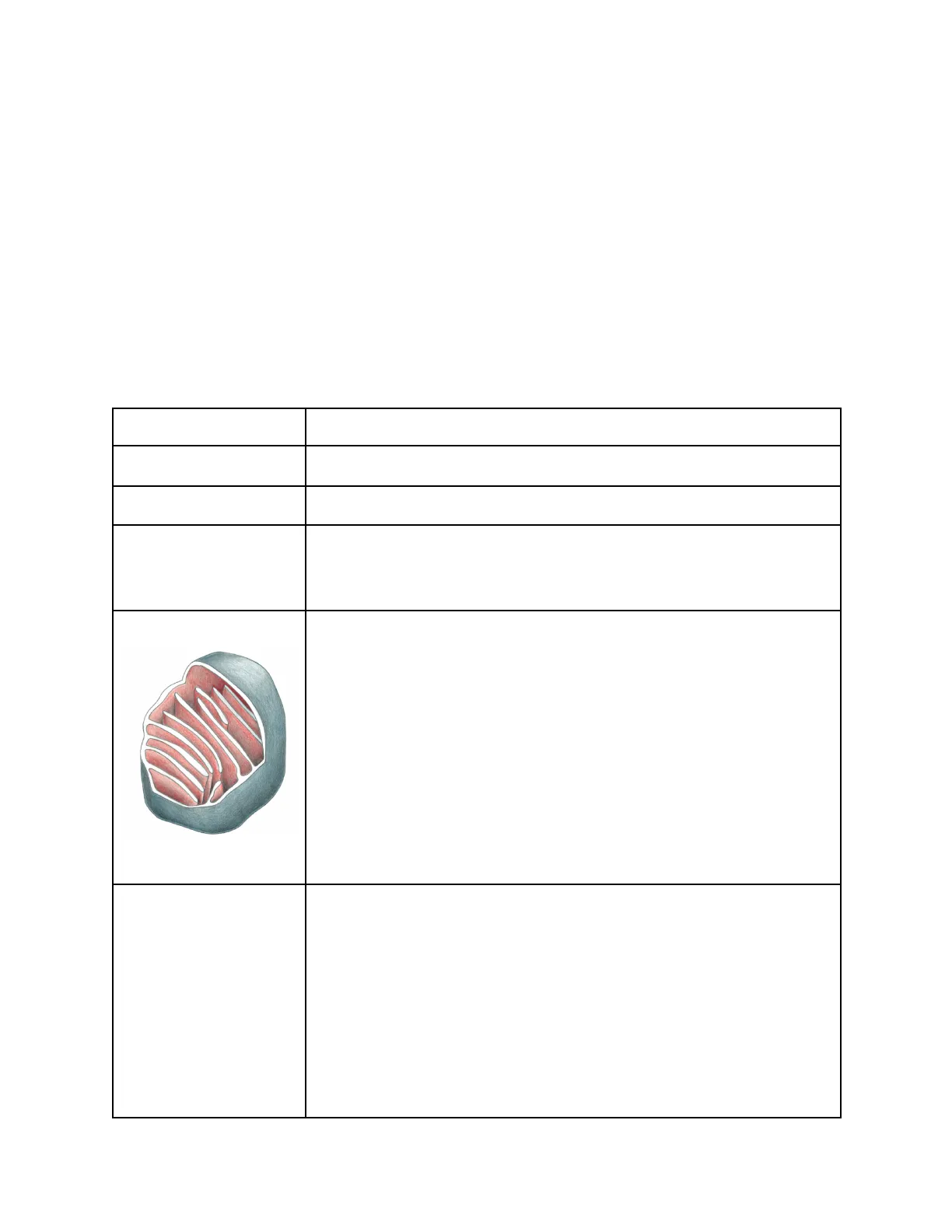Week 1: Cellular Biology and Genetics, University Notes
Document from University about Week 1: Cellular Biology and Genetics. The Pdf covers key concepts in cellular biology and genetics, including cellular diversity, organelle functions, purification processes, and genetic mutations, relevant for University Biology students.
See more41 Pages


Unlock the full PDF for free
Sign up to get full access to the document and start transforming it with AI.
Preview
Cells: Basic Unit of Life
Cells: Basic unit of living organism, aqueous, enclosed by membrane and can self replicate
Diversity of Cells
Diversity of Cells comes from:
- Size
- Shape
- Chemical requirements
This diversity reflects function:
- Factories for production of hormones, scratch, fat, latex or pigments
- Burn fuel for mechanical work
- Generate electrical current
Living Things Characteristics
Living Things:
- Are organized
- Maintain homeostasis
- Reproduce
- Grow from simple
- Transform energy from the environment
- Respond to stimuli
- Adapt to environment
Sexual Reproduction- Fusion of two cells of same species pooling DNA Evolution- Gradual change in organisms over generations
- Believed that all cells stem from same ancestral cell
Major Divisions of Life
3 Major divisions of living things were found by comparing the genomes (Sequences) of various organisms.
- Bacteria
- Archaea
- Eukaryotes
Bacteria
Bacteria-
- Dominant and most diverse
- Most commonly single celled organisms, can join together to form multicellular structures
- Extremely small
- Cell wall surrounding plasma membrane containing cytoplasm and DNA
- Reproduce extremely quickly
- Group together in chains or clusters
- Shapes are spherical, rodlike or corkscrew
2 um spherical cells, e.g., Streptococcus rod-shaped cells, e.g., Escherichia coli, Salmonella spiral cells, e.g., Treponema pallidum
Aerobic- Use oxygen to oxidize food molecules Anaerobic- Do not use oxygen
- Carbon in any form is most common source of food
- Photosynthesis is a common example
- Mitochondria have evolved from bacteria
Archaea
Archaea-
- Found in hostile environments
- High temps, pH, low oxygen ect ..
- Resemble bacteria in outward appearance, more similar to eukaryotes in genome sequences
- Asgard cells were used to see resemblance
Eukaryotes
Eukaryotes Eukaryotes- Organisms whose cells contain distinct nucleus and cytoplasm
- Much larger
- Includes animals, plants and fungi- Along with a nucleus there are additional organelles (With membranes) present in eukaryotes.
Prokaryotes- Absences of a nucleus (archaea and bacteria) Yeast- Simple free living eukaryotes, use budding (asymmetrical dividing) to reproduce.
Organelle Functions
Functions of organelles were found by spinning the contents of a cell in a centrifuge to divide out organelles and tested what chemicals they released and their size/density.
Organelle/Part Function Nucleus Contains DNA of organism Nuclear Envelope Two spherical membranes containing nucleus
Chromosomes
Chromosomes
- Long threadlike structure composed of DNA and proteins that carry genetic information.
- Becomes visible during cell division
Mitochondria
Mitochondria
- Membrane enclosed
- Performs oxidative phosphorylation and produces most of the ATP in the cell (Chemical energy)
- Oxidize food molecules into ATP (Consumes oxygen Releases CO2) called Cellular Respiration
- Inner membrane which creates folds within the structure
- Contain own DNA and reproduce by dividing (Proves relation to aerobic bacterium engulfed by an anaerobic ancestor of present day eukaryotic cells)
- Symbiotic relationship with eukaryotic cell, provides both with metabolic support allowing for survival and reproduction
- Suggested that an asgard archaeon was the original capturer of the mitochondria
Chloroplasts
Chloroplasts
- Large, green only found in plants and algae
- Two membranes (Inner and outer)
- Internal stacks of membranes containing green pigment Chlorophyll
- Capture sunlight energy
- Carry out Photosynthesis (use of sun, carbon dioxide and water to form organic molecules - sugars and release oxygen byproduct)
- Produce the food and oxygen for the mitochondria to generate chemical energy (ATP)
- Evolved from photosynthetic bacteria engulfed by eukaryotic already containing mitochondria (Evolved after)chlorophyll- containing membranes inner membrane outer membrane
Endoplasmic Reticulum
Endoplasmic reticulum
- Irregular maze enclosed by a membrane
- Components and materials that are being exported out of the cell are made here
- Secrete large amounts of protein
Rough ER:
- Contain ribosomes used to translate RNA into protein
Smooth ER:
- No ribosomes
Golgi Apparatus
Golgi Apparatus
- Membrane enclosed
- Stacks of flattened sacs
- Modifies and package molecules made in the ER
05 O (A)
Lysosomes
Lysosomes
- Small, irregularly shaped
- Intracellular digestion occurs
- Releases nutrients from ingested food particles into cytosol
- Break down unwanted particle for recycling or removal from cell
Peroxisomes
Peroxisomes
- Small, membrane enclose
- vesicles that provide an isolated environment for reactions in which hydrogen peroxide is used to inactivate toxic materials
Transport Vesicles
Transport Vesicles
- membrane formed
Cytosol
Cytosol
- Everything left over after the membrane contained organelles have been removed
- Fraction of cytoplasm
- Water based gel solution containing variety of molecules
- Site of many chemical reactions
- In constant motion due to random thermal motion (molecules collide)
Cytoskeleton
Cytoskeleton
- Crisscrossing long fine fragments within the cytosol
- Anchor one end of the plasma membrane
- Give cell shape and capacity for directed movements
- Filaments assemble and disappear when needed
Three Filament types:
- Actin filaments: small, central part of machinery for muscle contraction (large amount in muscle cells)
- Microtubules: Largest, hollow tubes in dividing cells that help pull apart duplicate chromosomes
- Intermediate filaments: intermediate in thickness, strengthen animal cells
duplicated chromosomes (A) (B) (C)
Cell Wall
Cell Wall
- Only in plant cells
- Provide additional structure and support
Evolution of Mitochondria and Chloroplasts
How Mitochondria and chloroplasts evolved:
nonphotosynthetic bacteria photosynthetic bacteria plants animals fungi archaea chloroplasts single-celled eukaryote - TIME - mitochondria bacteria archaea ancestral prokaryote
Membrane Transport
Endocytosis and Exocytosis across plasma membrane:
IMPORT BY ENDOCYTOSIS endosome plasma membrane Golgi apparatus EXPORT BY EXOCYTOSIS
- Continual exchange of materials occur between ER, golgi apparatus, lysosomes, plasma membrane and outside of cell
- Transport vesicles mediate. They pinch off the membrane of one organelle and fuse to another
- Endocytosis- Carry in external materials
- Exocytosis- release of internal components to external
Motor Proteins- use energy stored in ATP to move through cytoplasm microtubules 20 μm
Cell Types
ANIMAL CELL centrosome with pair of centrioles microtubule chromatin (DNA) extracellular matrix nuclear pore vesicles 0 0 lysosome mitochondrion 5 um nucleolus endoplasmic reticulum nucleus plasma membrane ribosomes in cytosol Golgi apparatus intermediate filaments Golgi apparatus nucleolus mitochondrion chromatin (DNA) nuclear pore cell wall microtubule C vacuole (fluid-filled) peroxisome chloroplast ribosomes in cytosol PLANT CELL actin filaments lysosome 1 μm Three cell types are drawn here in a more realistic manner than in the schematic drawing in Figure 1-25. The animal cell drawing is based on a fibroblast, a cell that inhabits connective tissue and deposits extracellular matrix. A micrograph of a living fibroblast is shown in Figure 1-7A. The plant cell drawing is typical of a young leaf cell. The bacterium shown is rod-shaped and has a single flagellum for motility. A comparison of the scale bars reveals the bacterium's relatively small size. - flagellum ribosomes in cytosal outer membrane DNA plasma membrane cell wall BACTERIAL CELL . actin filaments peroxisome 5 um
Protozoans
Protozoans- A free living, nonphotosynthetic, single celled, mobile, eukaryote that lives in solitary
- Do not range in environments but range in behaviour and appearances
- Photosynthetic or carniverous
- Vary versitile in shaps and sizes
- Ex. Didinium- large, fast, carnivourus, paralyses prey and devours
Model Organisms for Study
Model Organisms- Living things selected to be studied as representatives of larger groups
Escherichia Coli
Escherichia Coli- Representative of Bacteria
- Small, rod shaped cell
- Lives in guts of humans and vertebrate
- Revealed how cells regulate gene expression and replicate and decode DNA to make protiens
- Used to produce large quantities of proteins such as insulin
Saccharomyces Cerevisiae
Saccharomyces cerevisiae- Model Eukaryote
- Also called Brewer's Yeast
- It is difficult to model and study eukaryotes directly, yeast is an easier representative
- Very closely related
- Small single celled fungi more closely related to animals then plants
- Cell wall, immobile and many organelles
- Understanding mechanism of cell division
Arabidopsis Thaliana
Arabidopsis Thaliana- Model Plant
- Understanding of mechanisms that enable palnts to grow towards sunlight and cycle of seasons
Other Model Animals
Other Model Animals
- Nematode worm (Caenorhabditis elegans)
- Extremely precise organisms (exactly 959 cells)
- View cell prescision with strict rules
Fruit Fly (Drosophila melangaster)
- Study of animal genetics (genes carry chromosomes)
- Genetic instructions in DNA lead to development of zygote to adult
- Extremely similar to humans
- Zebrafish
- Insight to developmental process (heart and blood vessels)
- Transperant fir first 2 weeks of life
- Mice
- Can be delibratly mutatated
- Understand how specific genes work in humans
- Scientists worked backwards by isolating organisms that are defective in cells to discover which protiens control cell cycle
- Successful in yeast (Reproduce rapidly)
- S. Pombe is where cdc and cdc2 genes for division were isolated (rod shaped divides by elongation)
- Placed mutant S. Pombe (Could not divide in warm temp) DNA in S. Cerevisiaeand it was able to regain function
- Even when using human DNA the results were the same proving the protien for cell division is the same in yeast and humans and all eukaryotes
- Indicates that the mechanisms for reading coded DNA are also the same
Human Models
Human Models- In vitro- in glass (cells get cultured) In vivo- in living (cells get cultured) Not always possible
- When harvested some cells will continue to perform same functions outside organism (Ex. Beating / Forming connections)
- Organoids- Some embryo cells can be coaxed into differentiating into various cell types
- Humans can also be studied in clinics
Bonding in Water
Bonding H2O
- Two extremely polar H-O bonds due to O high attractiveness
- Positive charge due to two H (+) and one O (-)
- Liquid at room temp, high boiling point and surface tension
Hydrogen Bonding
Hydrogen Bonding- Weak Non covalent interation between positive H and negative O, N, or F of another molecule.
- Key to water molecule structure
- Easily broken by random thermal motions
- Can create a network of continually breaking and reforming bonds (water)
- Can occur in single parts of a large molecule
Hydrophilic- water loving, rapidly forms hydrogen bonds with water Hydrophobic- water fearing, unchanged portion of molecule and does not form hydrogen bonds
Non-Covalent Bonds
Non covalent bond- Chemical association that does not involve shared electrons, singly weak, network is strong Electrostatic attraction- force that draws together oppositely charged atoms (Ex. ionic bonds; Non covalent), When + positive parts + + and negative + - + parts of a large + molecule meet, + + - electrostatic + + interactions draw them together (proteins)
- Van der Waals attraction- Weak non covalent due to fluctuating electrical charges that come into play between two atoms located very close to each other (London Dispersion)
Length: Covalent < Noncovalent: Ionic < Noncovalent: Hydrogen bond < Noncovalent: Van der waals attraction Strength: Covalent > Noncovalent: Ionic > Noncovalent: Hydrogen bond > Noncovalent: Van der waals attraction